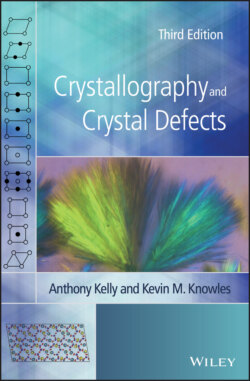Читать книгу Crystallography and Crystal Defects - Anthony Kelly - Страница 49
2.16 An Example of a Three‐Dimensional Space Group
ОглавлениеTo illustrate the principles we have outlined in Sections 2.12–2.14, an example of an entry from in Volume A of the revised, fifth edition of the International Tables for Crystallography [20] is shown in Figure 2.25. In the more recent sixth, revised edition of these Tables, the data tabulated in the revised, fifth edition on subgroups and supergroups of the two‐ and three‐dimensional space groups and shown in Figure 2.25 has been moved to Volume A1.
Figure 2.25 An example of a space group.
Source: Taken from [20].
It is apparent from the Hermann–Mauguin notation of this space group, Pnma, No. 62, that crystals with this space group symmetry belong to the orthorhombic crystal system, point group mmm. The Schoenflies notation indicates that the space group is dihedral (or two‐sided; from the ‘D’), that it has a twofold rotation axis (from the ‘2’), that there is in addition a mirror plane perpendicular to this twofold axis (from the ‘h’ subscript) and that it is the 16th of 28 such space groups … (space groups 47–74 inclusive), all of which are space groups derived from the mmm point group.
The full Hermann–Mauguin notation for this space group is P21/n 21/m 21/a, showing that there are three mutually perpendicular sets of screw diads in addition to the mirror, m, and the diagonal, n, and axial, a, glide planes. The diagrams of the symmetry elements of the group follow the principles in Figure 2.24, with the use of standard graphical symbols for n (parallel to (100)) and a (parallel to (001)). The projections in the top left‐hand corner and the bottom right‐hand corner are both down [001], the one in the top right‐hand corner down [010] and the one in the bottom left‐hand corner down [100].
The asymmetric unit is ‘a (simply) connected smallest part of space from which, by application of all symmetry operations of the space group, the whole of space is filled exactly’ [20]. The listing under the heading ‘Symmetry Operations’ in Figure 2.25 is a summary of the various geometric descriptions of each of the eight symmetry operations in the space group, numbered (1)–(8). Thus, for example, here the second of these, 2, 0, z, defines the screw diad parallel to [001] intersecting the x–y plane at (, 0). The ‘Generators Selected' define the order in which the coordinates of the symmetrically equivalent positions are produced; for example, the coordinates related by symmetry to the general position x, y, z in the space group. (1) is the identity operation, showing that in this case integral lattice translations produce the equivalent point in adjacent unit cells. After the ‘Positions', which follow the protocol described in Section 2.12, and the ‘Symmetry of Special Projections', which are self‐explanatory, a summary is given of subgroups and supergroups related to the space group under consideration, following the methodology set out in chapter 2 of [20]. Finally, the reflection conditions listed under ‘Positions’ specify the systematic absences which occur under kinematical diffraction conditions, such as X‐ray diffraction.
